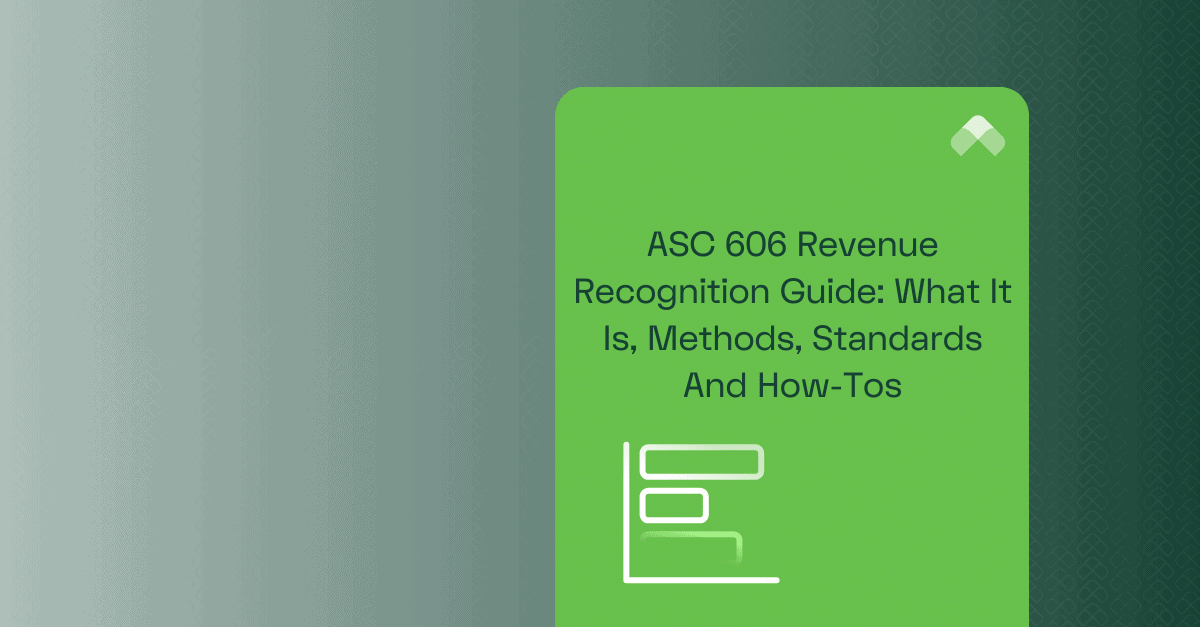As customers increasingly demand flexibility in sales negotiations, bundling products and services or offering mixed discounts is becoming more popular in today’s market.
However, accounting standards like ASC 606 have added additional complexity to multi-element revenue models. ASC 606 states that businesses with multi-element customer contracts must determine the transaction price and allocate it to each performance obligation based on the relative standalone selling prices of the goods or services being provided to the customer.
Your standalone selling price (SSP) measures how much an individual item or performance obligation would sell for in an isolated scenario—without packages or other deals.
Complying with Generally Accepted Accounting Principles (GAAP) obligates that you understand your SSP—especially ASC 606’s rules on allocating transaction prices. Let’s explore the importance of standalone selling prices, consider different ways to calculate them, and investigate the challenges, solutions, and technologies available to facilitate SSP revenue calculation for your business.
What Is Standalone Selling Price (SSP)?
Imagine conducting all your sales individually, without package deals, customer relationships, or negotiations. In this scenario, clients buy one item or sign contracts for singular performance obligations, and everyone pays the same price.
That’s the idea behind SSP—if all your products, services, and offerings were decoupled from each other and sold separately, how much would each cost? Determining SSP is necessary, as failure to do so can lead to significant revenue misstatements.
Tech and software companies often have the most difficult time determining standalone selling prices as:
- Almost all sales bundle software, hardware, usage licenses, services, maintenance, support, and more into singular agreements.
- These different factors are rarely broken apart from each other when it comes to pricing the final deal.
- Salespeople tend to offer discounts, but not uniformly across items. Instead, they deviate from the “standard” prices of various offerings to build custom package deals for their clients.
Regardless of how difficult bundling and discounts make estimating standalone selling prices, it’s still a crucial accounting process for your company to establish.
Importance of Standalone Selling Price
ASC 606’s standardization of accounting procedures outlines a five-step process for recognizing revenue. It’s steps three and four which highlight the importance of calculating SSP for any business:
Step 3: “Determine the transaction price.”
And
Step 4: “Allocate the transaction price to the performance obligations in the contract.”
To satisfy this revenue recognition principle, each aspect of your performance obligations—in essence, each separate product or service you offer—must have a traceable transaction price.
Determining your SSPs allows you to maintain ASC 606 compliance in your financial reporting. Thus, when it comes time to disclose your books—whether during shareholder inspections or an audit—you can rest assured everything will be in order.
However, determining SSPs can be a complex and labor-intensive process for revenue accountants. It involves reviewing extensive contract data and often relies heavily on judgment. While there’s no one-size-fits-all method, a thorough analysis of historical sales, market trends, and other relevant factors can help you establish defensible SSPs.
As mentioned, SSP is particularly important and hard to determine in the software industry, but it’s likewise a crucial aspect of accounting in:
- Services
- Manufacturing
- Defense
“With standardized pricing not always being easy to identify (i.e. List Pricing), it may be difficult to determine SSP. In those cases, it is important to understand the options available for calculating SSP and allocating revenue accurately.” – Andrew Trompeter, Solutions Consultant at RightRev
Methods to Determine Standalone Selling Price
Some businesses use their SSPs in day-to-day operations and always have a cut-and-dry figure for each item or service. Other companies, however, only calculate SSPs for revenue recognition purposes, lacking set, concrete prices for each offering. In these cases, they’ll determine their SSPs using one of the following approaches.
Adjusted Market Assessment Approach
This strategy considers the market you’re operating and selling to determine how much a customer would willingly pay for your offerings. You should consider your competitors’ pricing as representative standalone selling prices for similar products and services but adjust them for business-specific factors such as your:
- Place in the market
- Projected profit margin on each offering
- Pricing structure
- Distribution channels and costs
- Clientele and geographic segmentation
Likewise, you also need to factor in current market conditions, such as:
- Your competition
- Geographic factors
- Ongoing trends
- Market perception of your brand
- Supply and demand
Depending on what your entity sells and what you consider your market, a single good or service could exhibit varied standalone selling prices in different places.
For example, physical goods could sell for far more in a difficult-to-access rural area than in a globally connected port city. Likewise, well-known brands can generally demand more for their offerings than young startups.
Consider your place in the market, geographic location, and your position in consumers’ minds to arrive at the most fitting estimate for the going rate of your offerings.
Under this approach, if you have enough sales history for standalone transactions with singular performance obligations, it is possible to use a statistical method to establish your standalone selling prices by analyzing the normal distributions of the performance obligations’ sales history under different sales stratifications.
Expected Cost Plus Margin Approach
Expected cost plus margin considers the price of producing a good or service plus the profit you expect. When determining your own cost on a singular good, factor in:
- The price of materials
- Labor and wages
- Other associated costs—such as research and development, rent, and utilities
Any indirect costs, such as rent, should be proportionately adjusted to match the amount invested in that particular item. Likewise, when determining your reasonable projected margins on a sale, be sure to consider:
- Your margins on SSPs of similar products
- The historical margins within your industry
- The average sale prices in your industry
- Market conditions
- Your profit goals
Ensure consistency when using expected cost plus margin to determine your SSPs. Only adjust your margins if you have reasonable evidence that you can sell your goods or services for an adjusted price rather than setting SSPs based on the margins you hope to achieve.
For example, hardware providers often have a standardized cost associated with all pieces of hardware that they sell (including labor and overhead). In a cost plus margin approach, the company would calculate these costs for every transaction and then add a margin, say 10%, to estimate their SSP for each line item. Calculating and justifying the specific margin applied is part of the struggle with this approach and it is often ever-changing.
Residual Approach
Using the residual method to estimate SSPs may be appropriate if you have highly variable or uncertain standalone selling prices. In some scenarios, it is difficult to determine the cost associated with an individual performance obligation accurately, and determining factors within the market are unknown. In those extenuating circumstances, it may be apt to rely on the residual method for calculating SSP.
The residual approach works by removing the observable standalone selling prices of the obligations with standalone selling prices that are readily determinable from the total aggregate price:
- Subtracting the observable standalone selling prices from the aggregate standalone selling price by allocating them to more defined obligations (i.e., the obligations with pricing factors that are more concrete and static between sales).
- Allocating the remainder (i.e., the residual) of the aggregate price to more variable or uncertain performance obligations.
For this method to work, you’ll need to have performance obligations with identifiable, non-variable SSPs on each contract. Otherwise, you may consider using another technique (alone or in tandem with the residual approach) to estimate your SSPs.
The most important factor when utilizing the residual approach or any other SSP calculation method is defensibility. Are you making the most appropriate bookkeeping choices when calculating costs and sticking to GAAP? If it stands up to your accounting department’s scrutiny, shareholder examination, and audits, then you’ve chosen the right method. As a general rule, you should seek advice from your auditors on the best approach to determining your standalone selling price(s.)
Practical Considerations and Challenges
Besides the difficulty of selecting the right SSP calculation method, there are other practical factors and potential challenges to navigate. There may, for instance, be various issues related to data collection and analysis, including:
- Obtaining accurate, comprehensive data: Whether it’s information on current market rates, your brand’s perception, or material costs, myriad variables factor into SSP calculations. Obtaining accurate data on all these factors can be difficult—especially when you don’t have the time or budget to do your research.
- Selecting the right tools and technology for data management: Gathering accurate data presents one hurdle, but storing and accessing it can continually introduce friction. Consider different customer relationship management (CRM) systems and similar digital tools to help you facilitate data management.
Once you have reliable access to a solid database, you can consider how to determine your SSPs and begin calculations. Keep in mind, however, that as you start the process, you may encounter issues with the following:
- Complex product and service bundles: Packaging multiple items together into singular bundles at discounted rates changes the average price for each item, confusing the process of establishing reliable SSPs.
- Dynamic pricing models: When fees (perpetually) remain up for negotiation, customers may pay widely different amounts for the same services. This complicates the concept of SSPs because even an average or median price under these models may not represent the real value of completing your performance obligations.
- Market fluctuations: When using the adjusted market assessment approach, sudden industry fluctuations may necessitate recalculating your SSPs. If the commodity price of a good you sell shoots up significantly, you must update your estimated standalone selling prices to account for the increased potential revenue you’ll likely make.
- Poor data: In addition to the aforementioned market data, which can be difficult to collect accurately, failing to track your historical prices and calculate their place in your SSPs is another way incomplete or inaccurate information can hinder your revenue recognition procedures.
- Large product catalogs: Everything you sell needs an SSP, but the more items you offer, the more likely you are to sell them as bundles. This confuses the SSP of each item as their sale costs will vary based on the other products they’re packaged with.
All these factors can make estimating SSPs confusing. If you’re struggling to determine what method to use to calculate your SSPs, review our ASC 606 Revenue Recognition Guide inside and out and consult experts such as auditors or consulting firms.
SSP Best Practices
To estimate your SSPs with as much accuracy and honesty as possible, you should:
- Regularly review and update your SSPs: Refreshing SSPs with the latest market information, material costs, and company knowledge keeps them as accurate as possible. A common, accepted practice is to review your SSPs annually at the start of each new audit cycle.
- Foster cross-functional collaboration between different departments: When product or market data is siloed in a singular team, it can’t be circulated to benefit others. Similarly, if salespeople don’t understand how their deals and bundles affect the accounting process, they’ll offer discounts without regard for SSPs. Make sure everyone shares relevant data across your business and understands the basics of your revenue recognition process.
Technologies That Can Help with SSP Determination
Calculating SSP can be a complex task, but modern accounting automation tools and other commercial software can significantly simplify the process. As mentioned, you’ll want a robust CRM such as Salesforce to organize customer information and keep track of other relevant data. Still, you’ll need an even more intelligent revenue recognition tool to calculate and report SSPs accurately.
With an effective revenue recognition solution like RightRev, you can take most of the manual work out of determining standalone selling prices. It’ll even automatically apply SSPs to your performance obligations—including accurately allocating them to multiple obligations within bundled contracts.
RightRev works by conducting an intelligent historical analysis of the factors contributing to your SSPs. In the same way a professional accountant considers different SSP models and advises the most fitting one for your needs, RightRev will determine the most appropriate approach to your SSPs.
RightRev isn’t only essential for SSP analysis, however, as it also automates many other accounting tasks, including:
- Posting revenue journal entries to your general ledger
- Modifying contracts and recalculating revenue in line with the new agreements
- Recognizing revenue across all facets of your business with whichever revenue recognition methods your company favors
Epicor, a business software company based in Austin, experienced major issues with data accuracy and reporting. Inconsistent integration between its CRM and accounting software caused confusion, affecting numerous reporting metrics, including SSP.
Epicor turned to RightRev to realign their Salesforce data with their actual revenue figures to solve their issue. In little time, they significantly decreased their manual inputs on SSPs, contract modifications, allocations, and more.
Any tech company that bundles its sales benefits from implementing RightRev. Often, package deals don’t separate line items, selling one at $0 and the other for an inflated cost to reach the total transaction price. GAAP doesn’t support this model; however, maintaining regulatory compliance necessitates determining your SSPs and allocating transactional value for each performance obligation based on those calculations.
Expedite Accurate SSP Estimation With RightRev
Your SSPs represent the costs of your singular goods or services when they’re unbundled, not discounted, and sold as individual items. You could calculate your SSPs in numerous ways, but whichever you choose, ensure it’s defensible and in line with GAAP.
Although perhaps tempting, avoiding allocations and SSP reporting leads to countless hours of manual adjustments down the road—not to mention the potential for fines, other legal repercussions, and the loss of your customers’ trust.
SSP reporting is essential to satisfy ASC 606’s rule about allocating transaction prices. In essence, all transactions must be allocated to performance obligations within contracts. All singular items can, in themselves, constitute an obligation and, therefore, must have an assigned SSP.
RightRev is a robust ASC 606 solution that can simplify determining SSPs for your goods and services. Utilizing our SSP calculator option, RightRev can conduct in-depth historical analyses of past sales figures and other factors contributing to SSPs, taking most of the manual work out of this tedious, involved accounting task.
Adopt the practices listed here and try RightRev today to automate SSP calculation—plus many other time-consuming accounting tasks.
Watch a quick demo on standalone selling price within RightRev below:




